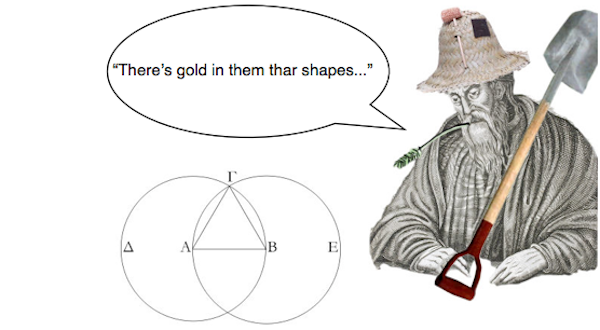The Rhetoric of Web Design
 Euclid, the web conversion prospector
Euclid, the web conversion prospector
Part 2: Logos/Reason
In part one of incorporating rhetoric in your web design and conversion optimization, you established relevance and credibility, earning trust from your brand new visitor.
Congratulations. The skittish squirrel that is the modern day web surfer has not retreated away from you.
But if you’re like most businesses, you don’t just want to accumulate a pile of visitors. That’d be creepy. You want them to take an action on your site, to satisfy all of their capitalist urges and rejoice like fully realized agents of desire and discretion.
Ok, maybe not that. But you do want to convert visitors into customers.
By relying on logic as the initial means of your persuasion, then you’ll be appealing to the highest (and most trusted) capability in your visitors, and following in the footsteps of centuries of persuasive writers.
Three Areas of On-Site Logic
From the early days of Euclidian geometry, logic has influenced all sorts of fields, from law to philosophy to computer science. And for a business website aiming to convert visitors, there is no ‘i’ in ‘logic.’ There are three of them:
Information, Identity, and Incentive
That’s because logic doesn’t just apply to the way in which you write sentences. It also applies to the structure of your site, the order in which you anticipate questions, and the way in which you present facts.
Information Architecture
The organization of your website’s information speaks to an overarching, binding logic that influences the main persuasiveness of your site.
And this organization goes beyond your page layouts. It’s important to have the information architecture of your entire site structured in the most intuitive, clean way so that a user can appreciate the natural rationale that influences their navigation.
A good way to do this is to “nest” your pages within broader categories, and to do this continually as you drill down into deeper and deeper pages. Avoid rogue pages and the practice of linking to pages solely within the body copy of various internal pages. Using a categorized drop down navigation, as well as secondary navigation bars that change within different sections will help with the transparency of your system. Your middle school history teacher would be proud if they saw your site architecture somewhat resemble the outline you wrote for your Civil War research paper.
Taking pains to structure your site in a deliberate, logical way will do several things.
- Engage and unclutter the visitor’s mind – A clear, logical structure will not only captivate an interested visitor, but it will also allow them to spend more mental energy considering your content or the “value proposition” of your call to conversion.
- Grease the wheels of navigability – A more comfortable site to navigate should lead to an easier path to conversion.
- Establish a reputation of intelligent logic – A business that values logic at all levels will engender trust and appreciation in a potential customer, whether they are consciously aware of it or not.
Identity
As with any new proposition, a visitor automatically seeks the answer to the essential questions: Who, What, When, Where, Why and How?
A good site will anticipate the order in which these questions should be satisfied. A great site will also understand the logical connection between them.
Depending on your type of business and the type of conversion you’re seeking, some of these questions will be more relevant than others. After you figure out which apply to you, then you can link causal relationships between two, three, or possibly several.
For instance, you can use certain phrases to help you relate these answers:
Because this is who we are, this is how we do it.
Because this is why x is important, this is what y is.
There are lots of ways to link these bits of crucial information, and if they are presented in a way that anticipates the visitor’s curiosity and then strengthens their logical connection to one another, the business achieves some existential validity and improves its chances of converting potential customers.
Incentive
Ultimately, when talking about your service or product, you are creating some kind of incentive. A couple of ways to logically present this incentive are as follows:
Cost/Benefit
If the target audience is particularly price conscious, or your main differentiator from the competition is cost, then you can find ways to underscore the favorable cost/benefit ratio of converting.
By understanding what type of consumer you are trying to target, you can hone the type of cost/benefit analysis you underscore. Depending on their orientation, you may want to highlight unlimited service, bundled packages, a la carte programs, etc.
Feature/Benefit
Tying the unique feature of your service/product to the benefit is a great way to solidify the reason for your service/product to exist in the first place. This seems like a no-brainer, but a lot of business websites don’t explicitly tie these two things together in a compelling way, or even at all.
An overemphasis on features will inhibit the visitor from relating it to their own needs. Conversely, an overemphasis on benefits will make the unique position of your product fade into the background, and allow room for your competitors.
Next Up: Emotional Motivation
Establishing a logical argument is hugely important for conversing with potential customers in the language they hold most reliable and steadfast. This helps to support purchase decisions far beyond the first “click” and improve the chance that they will become repeat customers. But one of the most powerful rhetorical devices for turning that initial indecision into commitment is pathos, or an appeal to emotion. We’ll take a look at how you can weave emotion into the conversion funnel in the last part of this series of rhetoric in web design.
Note: I’m nominating my image above for the 2014 award categories of “Most Amateur Use of Photoshop” “Most Obfuscated Levels of Meaning in One Image” and “Weirdest Bastardization of a Greek Mathematician.” Your support is greatly appreciated.

